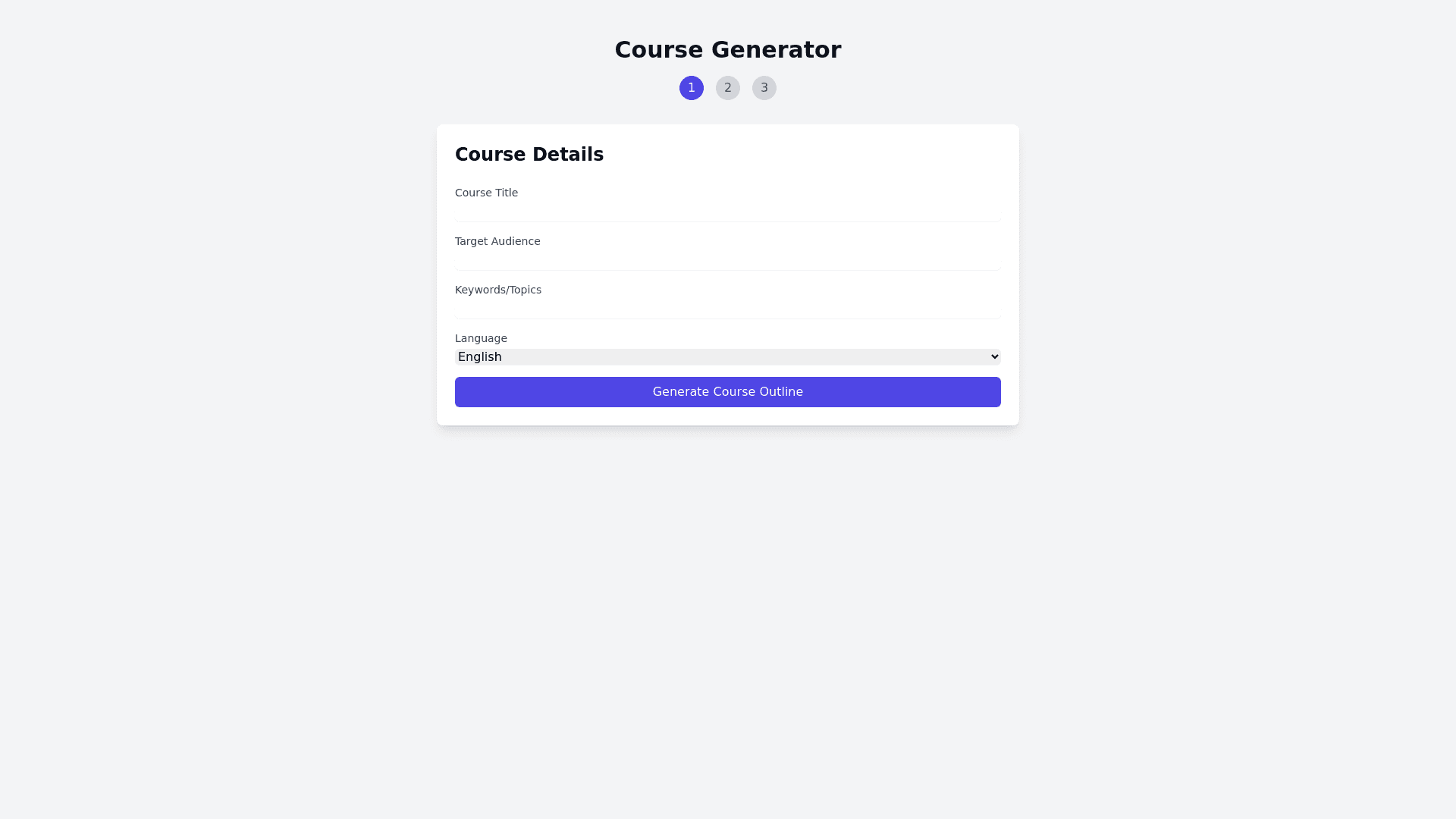Course Generator - Copy this React, Tailwind Component to your project
Here’s a detailed explanation of the “Course Generation Module” with a step by step flow, submodules, and fields: Module 1: Course Generation The Course Generation Module automates the process of creating a course by leveraging AI. Below is the workflow and the explanation of each submodule. Flowchart: Course Generation Start ↓ Input Course Topic & Details ↓ AI Generates Course Outline ↓ Customize Outline (Optional) ↓ Generate Lesson Content ↓ Generate Quizzes, Assessments, and Resources ↓ Export or Save Course ↓ End 1.1 Input Course Topic & Details • Purpose: Collect basic input to guide AI in generating the course. • Fields Required: • Course Title: Title of the course. • Target Audience: Who the course is for (e.g., Beginners, Intermediate, Experts). • Keywords/Topics: Specific topics or keywords to include in the course. • Preferred Language: Language for the course (e.g., English, Spanish). • Desired Duration: Approximate course length (e.g., 2 hours, 4 hours). • Learning Outcomes: What the student should learn (e.g., “Learn Python basics”). Example: • Title: “Python for Beginners” • Audience: Beginners • Keywords: Python, Programming, Basics • Language: English • Duration: 2 hours • Outcomes: “Write basic Python scripts, Understand Python syntax.” 1.2 AI Powered Course Outline Generator • Purpose: Automatically generate a structured outline for the course. • Process: • AI analyzes the input and divides the course into Modules and Topics. • Each module represents a broad section of the course (e.g., Introduction, Advanced Concepts). • Topics are individual lessons within each module. • Fields Generated: • Module Title: Title of the module. • Topic Titles: Title of each lesson/topic within the module. Example Output: 1. Module 1: Introduction to Python • Lesson 1: What is Python? • Lesson 2: Installing Python and IDEs • Lesson 3: Writing Your First Python Program 2. Module 2: Python Basics • Lesson 1: Variables and Data Types • Lesson 2: Basic Operators • Lesson 3: Control Flow (If Else) 1.3 Outline Customization (Optional) • Purpose: Allow users to tweak or reorganize the AI generated course structure. • Features: • Drag and Drop: Move modules or topics around. • Add/Delete Modules: Add new modules or delete unnecessary ones. • Edit Titles: Rename modules or topics. • Fields: • Edited Module Titles. • Edited Topic Titles. 1.4 Lesson Content Generation • Purpose: Generate detailed content for each lesson. • Process: 1. For each topic, AI creates: • Lesson Text: The main content of the lesson. • Examples/Code Snippets: If applicable. • Additional Resources: Links or references for further learning. 2. User can choose a writing tone: Casual, Formal, or Academic. • Fields Generated: • Lesson Title: Title of the lesson. • Content: Paragraphs explaining the topic. • Examples: Code snippets, images, or use case examples. • References: External links or citations. Example: • Lesson Title: What is Python? • Content: Python is a high level programming language known for its simplicity… • Example: print("Hello, World!") 1.5 Quiz & Assessment Generator • Purpose: Create interactive assessments to reinforce learning. • Process: • AI analyzes lesson content and generates: • Multiple choice questions (MCQs). • True/False questions. • Short answer questions. • Difficulty level (Beginner, Intermediate, Advanced) can be selected. • Fields Generated: • Question: What is Python? • Options: (a) A Snake, (b) A Programming Language, (c) A Game • Correct Answer: (b) 1.6 Additional Resource Generation • Purpose: Generate downloadable resources for students. • Types of Resources: • PDF Handouts: Summarize lesson content. • Infographics: Visual summaries of concepts. • Code Templates: Pre written code examples. • Fields: • File Type: PDF, PNG, ZIP. • Content: Summary text, visual assets, or code. 1.7 Export or Save Course • Purpose: Let users save or export the final course. • Options: • Export as SCORM (for LMS compatibility). • Export as HTML5 (for web based courses). • Export as PDF (for offline access). • Save to the platform (for future edits). Submodules Summary Submodule Description Key Fields Input Course Details Collect user input to guide AI in generating the course. Title, Audience, Keywords, Language, Duration, Outcomes AI Powered Outline Generator Automatically create course structure with modules and topics. Module Titles, Topic Titles Outline Customization Allow users to tweak the structure and rename modules/topics. Edited Titles Lesson Content Generator Generate detailed content for each lesson, including examples and references. Lesson Title, Content, Examples, References Quiz & Assessment Generator Automatically create quizzes and assessments based on lesson content. Questions, Options, Correct Answers Resource Generation Provide downloadable materials like PDFs, infographics, and code templates. File Type, Content Export or Save Course Export the course in desired formats or save for future editing. Export Type (SCORM, HTML5, PDF), Saved Course ID This module ensures that the course creation process is streamlined and customizable. Let me know if you need further elaboration or detailed field mappings for other modules!
